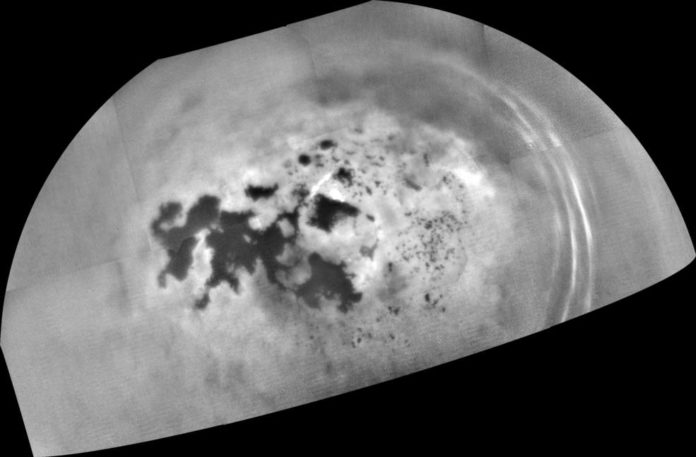
A study based on Cassini’s observation has stunned the scientists at NASA. The recent study, published in journal Icarus, shows, how the hydrocarbon lakes and seas of Titan erupt occasionally with dramatic patches of bubbles.
Researchers at NASA’s JPL, simulated the frigid surface conditions on Titan. They found that significant amounts of nitrogen can be dissolved in the extremely cold liquid methane. They also demonstrated that slight changes in temperature, pressure or composition can cause the nitrogen to rapidly separate out of solution. It looks like the fizz that results when opening a bottle of carbonated soda.
The researchers also coaxed nitrogen out of a simulated ethane-rich solution as the ethane froze to the bottom of their tiny, simulated Titan lake. By this they characterized how nitrogen moves between Titan’s liquid reservoirs and its atmosphere.

Credits: NASA/JPL-Caltech/Space Science Institute
According to them, ethane ice forms on the bottom of Titan’s frigid pools, unlike water where ice is less denser than it’s liquid form. As the ethane crystalizes into ice, there’s no room for the dissolved nitrogen gas. Thus, it comes fizzing out.
The release of nitrogen, known as exsolution, can also occur when methane seas warm slightly during the changing seasons on Saturn’s moon, Titan. This fizz can be a major problem while sending robots to the moon.
Cassini has also found mysterious island. During several flybys, Cassini’s radar has revealed small areas on the seas that appeared and disappeared, and then reappeared. Researchers proposed several potential explanations for this phenomenon. One of them was the idea of fields of bubbles. The new study provides details about the mechanism that could be forming such bubbles, if they are indeed the culprit.

Cassini will make its final close flyby of Titan on April 22. During the flyby, it will sweep its radar beam over Titan’s northern seas one final time. This will help the scientists confirm their hypothesis on the “magic islands”.
The flyby also will bend the spacecraft’s course to begin its final series, known as Cassini’s Grand Finale. The 20-year mission will conclude with a dive into Saturn’s atmosphere on Sept. 15.























